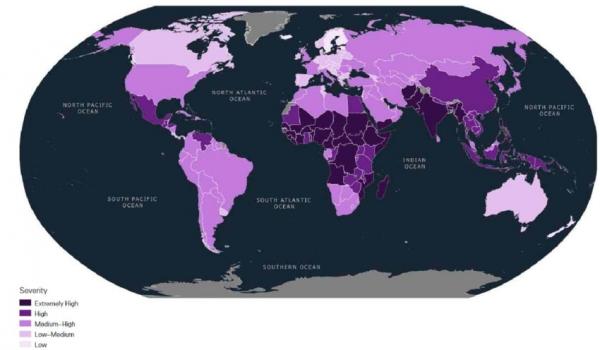UNICEF’s 2023 Children’s Climate Risk Supplement released ahead of COP 28
15 Nov 2023 by The Water Diplomat

UNICEF has released a 2023 supplement to its 2021 Children’s Climate Risk Index (CCRI) report ahead of COP 28 – the United Nations Climate Change Conference of Parties, which will take place in the United Arab Emirates from 30 November until 12 December 2023.
The supplement reveals an estimate that 1 in 3 children – 739 million children worldwide – are currently living in areas which are living in areas exposed to high or very high water scarcity, a situation which is likely to be compounded by the effects of climate change. Over the next three decades, a projected 4.2 billion children will be born, and they fall within the populations of concern who are vulnerable to the stressors associated with climate change. Examples of this vulnerability include the increased spread of diseases, the vulnerability to air pollution, the relatively low ability to regulate body temperature and the risk of dehydration.
This vulnerability, the report states, is particularly prominent in low-income countries. UNICEF notes an increase in the percentage of humanitarian appeals of the United Nations that arise from extreme weather from 36% in 2000 to 75% in 2021. And yet the climate vulnerability of children is not a topic that is prominent in the IPCC’s sixth assessment report or in projects supported through climate finance. Therefore, the report argues, children should be at the centre of the global response to climate change. “Adapting essential services, compensation for loss and damage, disaster risk reduction, early warning and increased investment in decarbonization can make the difference between life and death, a future or disaster, for the planet’s children”, the report states.
In 2021, UNICEF released a report on the Children’s Climate Risk Index which was the first comprehensive overview of children’s exposure and vulnerability to the impacts of climate change, developed to help prioritize action to support those most at risk. The report compiled geographical data which highlighted - in a series of different maps – the exposure of children to different climate related shocks such as heatwaves, water scarcity, cyclones, vector borne diseases, riverine flooding, coastal flooding, air pollution and lead pollution. By superimposing a variety of different risk indicators on a map of the world, UNICEF produced a map of the world which ranks countries on a scale from low risk to extremely high risk.
The 2021 report found that 33 countries fell into the category of ‘extremely high-risk’ and that these countries together emit less than 10 per cent of global greenhouse gas emissions. Of these 33 countries, 29 are also considered fragile contexts. However, a minority of these countries have mentioned children or youth in their Nationally Determined Contributions, and they received only a small amount of global financial flows devoted to clean energy development.
